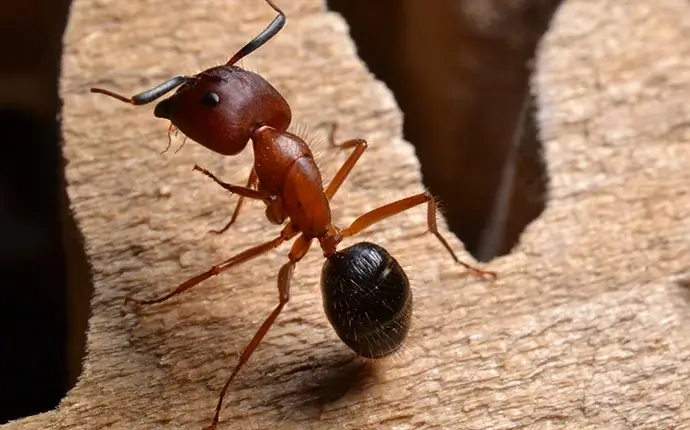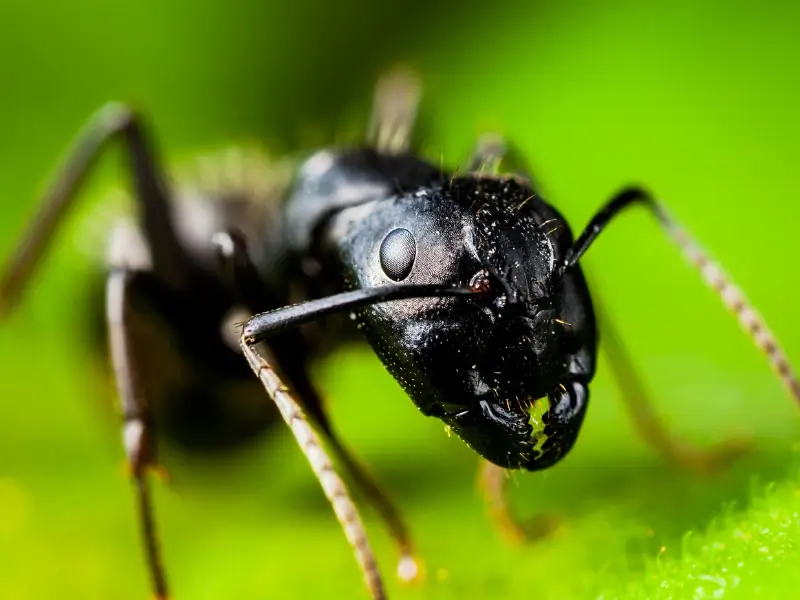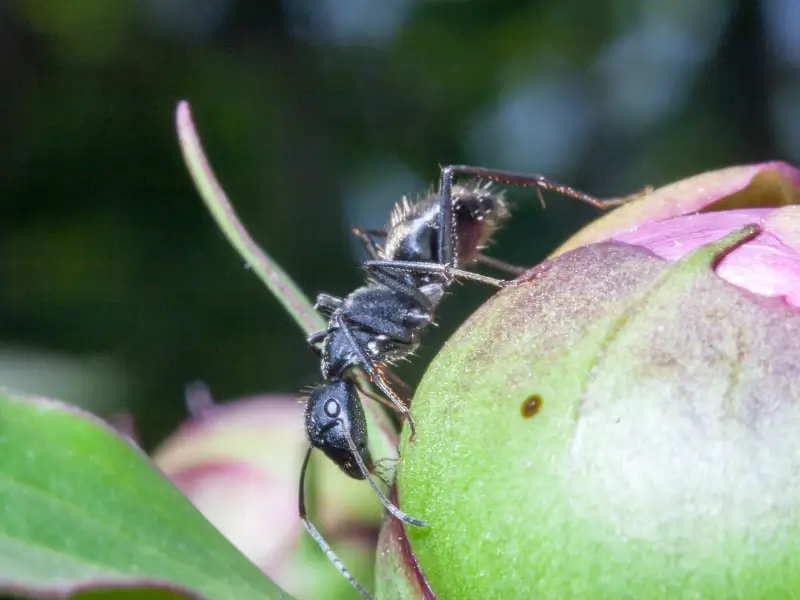
Carpenter Ant Damage: Don’t Let Ants Destroy Your Home
Carpenter ants have earned quite a reputation for wrecking our homes. While it takes time, carpenter ant damage can take a major toll on your home if left unchecked. There are also conditions that can increase their ability to damage your home. Let's talk about the signs of carpenter ant damage, factors that influence carpenter ant damage, and how you can prevent carpenter ants from taking over your home.

Table of Contents

What Are Carpenter Ants?
Carpenter ants are a type of wood-destroying insect that's common to homes in North Carolina. Carpenter ants, though not as notorious as termites, can wreak havoc on your property by tunneling through wood to establish their nests. Learn about the physical traits of these types of ants and where to find them.
Identifying Carpenter Ants in North Carolina
We've seen a lot of searches for, "big black ants in house," and "big black ants North Carolina" - and that's no surprise. Carpenter ants are common in North Carolina and can often live in homes without being identified properly. This is one of the biggest mistakes any homeowner can make.
Identifying carpenter ants involves recognizing several key features. These ants are larger than most common household ants, ranging from about 1/4 to 1/2 inch in length, and they vary in color from black to reddish or brown.
Carpenter ants have a distinctive single node between their thorax and abdomen, which distinguishes them from termites that have a straight waist. Another distinguishing feature is their elbowed or bent antennae.
Where to Find Carpenter Ants
Carpenter ants are often found in areas with moisture problems, and their presence can be indicated by the sound of rustling within walls as they tunnel through wood to establish their nests. They prefer damp and decaying wood, often making their nests in moist environments such as rotting trees, logs, stumps, and in or around structures with water damage.
Inside homes, they are frequently discovered in areas with high humidity levels, like bathrooms, kitchens, basements, and crawl spaces. Carpenter ants do not consume wood like termites but instead, excavate rooms and tunnels within it to create their nests.
Carpenter ant damage can lead to structural damage over time if left unchecked. Their ability to establish colonies in both natural and built environments makes proper identification and timely management crucial in protecting property from potential infestations.

Signs of Carpenter Ant Damage
It's important to recognize the signs of carpenter ant damage and take action when you see them. If left untreated, these ants can be incredibly destructive to your home over time. When you find signs of carpenter ant damage in your home, it's important to reach out to a pest control provider for professional home pest control.
Wood Shavings or Sawdust Piles
Carpenter ants excavate galleries within wood to create their nests, and this process often leaves behind wood shavings or little piles of sawdust, also known as "frass". If you notice piles of fine sawdust-like material around your home, particularly near wooden structures, this could be a sign of carpenter ant activity. The frass is a mixture of wood particles and ant waste, and its presence indicates that carpenter ants are actively tunneling through the wood.
Hollow or Damaged Wood
As carpenter ants tunnel through wood, they weaken its structural integrity. If you tap on wood and it sounds hollow or emits a dull thud instead of a solid sound, it might indicate that the wood has been hollowed out by these ants. Inspect wooden structures such as beams, rafters, window frames, and door frames for signs of damage, including cracks, holes, and tunnels. Keep an eye out for galleries that appear smooth and well-constructed, which are a characteristic feature of carpenter ant nesting.
Rustling Sounds in Walls
Carpenter ants are nocturnal creatures, and you might be able to hear them at night as they move and excavate within wood. If you listen closely near areas suspected of infestation, you may hear faint rustling sounds emanating from walls, ceilings, or other wooden structures. This auditory clue can help confirm the presence of these pests and their activity.
Discarded Insect Wings
During the process of swarming, which usually occurs in the spring, carpenter ants shed their wings. If you find insect wings around your home, it's a sign that a swarm of carpenter ants may have entered your home or are nesting nearby. Swarming is a critical phase of their reproductive cycle, and the presence of wings should prompt you to investigate further.
Factors that Influence Carpenter Ant Damage
Carpenter ant damage can create extreme problems for homeowners who don't catch an infestation in time. That said, there are a number of factors that influence carpenter ant damage. Additionally, there are preventative measures you can take to reduce the risks of carpenter ant damage. Let's take a look.
1. Time
They say, "Time heals all wounds." However, in the case of carpenter ants, time actually allows the wounds they cause to multiply. An infestation that begins with a single female winged carpenter ant can develop into a colony of several thousand worker ants in just a few years.
As the colony nears its maximum population, new male and female winged carpenter ants are created and released. Those reproductives then mate, the males die off, and the queens (females) go on to establish new colonies near the old colony, growing the infestation inside your home.
If this is allowed to continue, an infestation that started with a single carpenter ant colony can grow to consist of several nests and lead to major damages.
2. Moisture
Carpenter ants don't actually eat wood; instead, they chew tunnels and cavities in it in order to establish their nests inside. In your yard, they'll do this in a stump, a dying tree, an old fence, and pretty much any other decaying wood found on your property. When they are attracted to your home by a stump or other rotting wood, the next logical step is to get into your home.
The secret to resisting carpenter ants is to reduce the moisture conditions in your yard that allow water damage and wood rot to occur. This moisture may be from excessive sprinkler activity in your yard. It may be due to excessive shade created by a thick tree canopy. It may be due to the presence of leaves which can trap moisture underneath. It could be from a broken gutter.
There are many things that can cause excess moisture on our properties. To help solve your moisture problem, inspect your yard for moisture conditions and address them so that the wood in your yard and, more importantly, in your home, stays as dry as possible. This will help deter carpenter ants from being drawn to your property and home.
3. Water
Standing pools of water that form after it rains will not only increase the moisture in your yard, they can provide carpenter ants with plenty of water to drink. These pools can form for many reasons. It is important to search your property for these pools of water and address any conditions that are allowing standing water to accumulate.
4. Food
Carpenter ants subsist on a wide range of foods, but there are two they prefer: aphids and the honeydew created by those aphids. If you have lots of vegetation in your yard, you're likely to have lots of aphids. This will increase the population of carpenter ants in your yard, and increase the likelihood that they'll damage your home.
5. Lack of Knowledge
The biggest factor that leads to significant carpenter ant damage is a lack of knowledge. If you want to protect your home from carpenter ants, it is important that you understand that:
- A single carpenter ant crawling around inside your home is a warning sign of an infestation in your walls.
- Just because you only see one carpenter ant every once in a while doesn't mean your infestation is small. Carpenter ants are mostly nocturnal and only come out in large numbers when a food source is found.
- If you find winged ants crawling on an inside window pane, it is unlikely that they accidentally found their way into your home from the outside. Winged ants are attracted to light. They will not be attracted to the dimmer interior of your home. They're crawling on your window panes to get out to the outdoor light. That means the nest they came from is probably located inside your home.
- Carpenter ants are wired to be quite elusive. The galleries they create in wood are to protect them from predators. They aren't going to expose these tunnels to you or any other creature, if they can help it. The most you're likely to see of these tunnels are tiny kick-out holes, which they push out frass (fine sawdust) from.
- If you see a fine sawdust-like material in your home, that is a warning sign of a carpenter ant infestation.
Final Word: Carpenter Ant Damage
Vigilance is key when it comes to protecting your property from the damage caused by carpenter ants. Recognizing these signs early on can save you from extensive repairs and structural issues from a full carpenter ant infestation. If you've got carpenter ants in house and you live in Lenoir, West Jefferson, Blowing Rock, Mooresville, Hickory, or surrounding areas in North Carolina, call our exterminators. Our exterminators can inspect your property so you don't have to wonder whether you have carpenter ant damage.
If you find carpenter ants in your North Carolina home, reach out to us at A-1 Pest Control to make sure those carpenter ants are properly dealt with. We've been protecting the equity of homes from the threat of carpenter ants and other wood-destroying pests for over 50 years and we look forward to helping you protect yours!
What does carpenter ant damage look like?
Carpenter ant damage isn't always so obvious - unless you're falling through hollow wooden furniture. Spotting carpenter ant damage can take time. It's important to look for signs of tunneling in walls and wooden furniture. Sometimes carpenter ant damage appears as a hole that is frayed around the edges. It can look like dashes and dots running along a block of wood, or wood rot (especially since these ants prefer to attack rotting wood).
